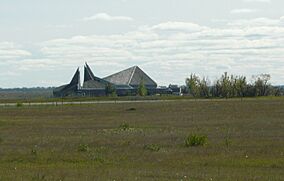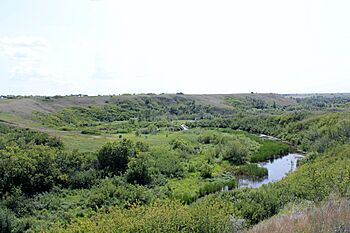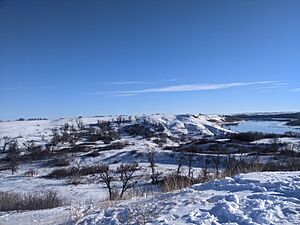Wanuskewin Heritage Park facts for kids
Quick facts for kids Wanuskewin Heritage Park |
|
|---|---|

Wanuskewin Heritage Park
|
|
| Location | Corman Park No. 344, near Saskatoon, Saskatchewan |
| Created | June 27, 1992 |
| Operator | Wanuskewin Indian Heritage Incorporated Wanuskewin Heritage Park Authority |
| Website | https://wanuskewin.com/ |
| Official name: Wanuskewin National Historic Site of Canada | |
| Designated: | 1986 |
Wanuskewin Heritage Park is a special place near Saskatoon, Saskatchewan, where you can learn about the history and culture of the First Nations people. It's a non-profit center and an archaeological site, which means scientists have found many old things there. The name "Wanuskewin" comes from the Cree word wânaskêwin, which means "being at peace with oneself."
This park is a National Historic Site of Canada because it holds important clues about the Northern Plains peoples' lives from almost 6,000 years ago. In 2016, Wanuskewin announced its goal to become a UNESCO World Heritage Site. If it succeeds, it would be the first World Heritage Site in Saskatchewan!
Contents
About Wanuskewin Heritage Park
For over 6,000 years, people have gathered at this special spot. Different groups of First Nations people, like the Cree and Assiniboine, came here. They hunted bison, gathered food and plants, and found shelter from the cold winter winds. Some of the oldest discoveries at the park are thousands of years old.
Wanuskewin is also home to a medicine wheel, which is a circle of boulders arranged in a special way. There are fewer than 100 medicine wheels left on the northern plains, making this one very important.
Location and Discoveries
Wanuskewin Heritage Park is located on the west side of the South Saskatchewan River. It's about 3 kilometers (2 miles) north of Saskatoon, along Opimihaw Creek. The park covers about 240 hectares (590 acres).
Within the park, there are 19 different sites that show how Northern Plains Peoples lived. These groups included the Cree, Assiniboine, Saulteaux, Atsina, Dakota, and Blackfoot. Scientists have found summer and winter camps, places where bison were hunted, and tipi rings. They have also found artifacts like pottery pieces, plant seeds, arrowheads, eggshells, and animal bones.
Park History and Recognition
Wanuskewin Heritage Park officially opened its doors in June 1992. However, scientific studies in the area began much earlier, in the 1930s. Today, the University of Saskatchewan continues to run archaeological research programs and active digs at the park.
The park was named a Provincial Heritage Property in 1984. It was the only site in Saskatchewan at the time that focused on prehistoric artifacts. In 1986, it became a National Historic Site. The next year, Queen Elizabeth II visited and unveiled a special plaque. In 2001, King Charles III, who was then the Prince of Wales, was given a special name, Pisimwa Kamiwohkitahpamikohk, by an elder at Wanuskewin. This name means "the sun looks at him in a good way."
Wanuskewin's main goal is to help people learn about and appreciate the rich history and culture of the Northern Plains First Nations people. It aims to do this in a way that can continue for a long time.
During the busy summer months, about 40 to 45 people work at the park. Wanuskewin serves as:
- A fun place for tourists to visit.
- A center for learning about science, culture, and education.
- A gathering place for important spiritual ceremonies today, like sweats and pipe ceremonies.
Wildlife at Wanuskewin
In December 2019, a herd of plains bison was brought back to Wanuskewin. This was a big moment because the park was historically a major bison hunting ground for many Indigenous groups. Six young bison calves came from Grasslands National Park. Later that month, one male bison and four pregnant female bison arrived from South Dakota. The male bison came from a wild herd in Yellowstone National Park.
The bison herd has been growing! On April 22, 2021, the first bison calf was born on the territory since 1876. Then, on September 12, 2021, another male calf was born. As of August 2025, the total number of bison at Wanuskewin is 18. The park hopes the herd will eventually grow to about 50 animals.
Opimihaw Creek
| Opimihaw Creek | |
|---|---|

Opimihaw Creek seen from outside the Wanuskewin complex
|
|
| Etymology | From Plains Cree 'opimihaw' meaning 'one which is swift/quick' |
| Province | Saskatchewan |
| Basin features | |
| River system | Saskatchewan River |
Opimihaw Creek is a small stream that flows through Wanuskewin Heritage Park and into the South Saskatchewan River. Its name comes from the Plains Cree word opimihâw, which means 'one which is swift' or 'pilot'. This creek has been important to Plains Indian peoples and their cultures for a very long time.
The Valley of Opimihaw Creek
The valley carved by Opimihaw Creek is a special feature of the park. It cuts into the river bank and is home to wetlands and various animals. Many First Nations people historically used this valley as a buffalo jump. This is a place where they would guide bison over a cliff to hunt them. Because of this, the valley is a very important site for archaeology.
There are about 20 different archaeological dig sites located around the creek within the park. Some of these sites are incredibly old, dating back as far as 6,400 years. This means they are even older than the famous Pyramids of Giza in Egypt!
See also
- List of National Historic Sites of Canada in Saskatchewan
- List of protected areas of Saskatchewan



